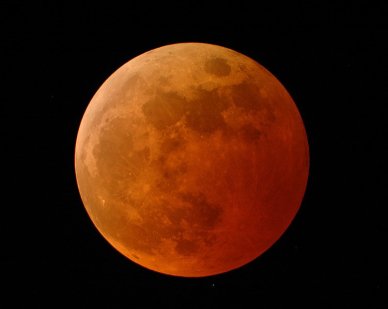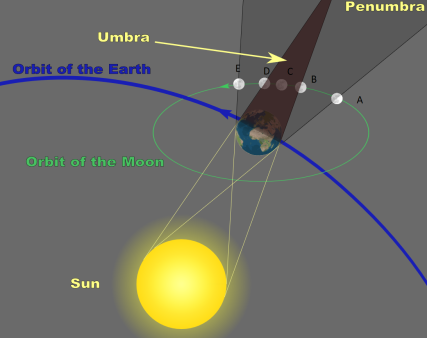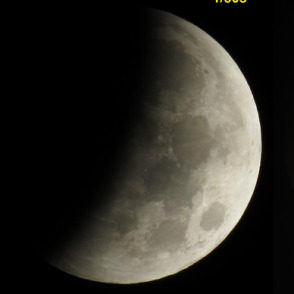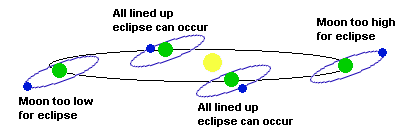On 28 September 2015 there will be an total eclipse of the Moon, which will be viewable from many areas of the world. It will be an interesting sight and worth getting up at an unsociable hour to see it, especially since there won’t be another total lunar eclipse until 2018.
The Moon during a recent total lunar eclipse – image from NASA
What happens during a lunar eclipse ?
A lunar eclipse occurs when the position of the Earth prevents some or all of the Sun’s light from hitting the Moon’s surface. This is shown in the diagram below:
The various stages of a lunar eclipse are as follows. In the first stage, the Earth blocks part of the Sun’s light from reaching the Moon. This will start at 01:12 am British Summer Time (BST) and is shown as A in the diagram. It is called the penumbral phase and is actually quite difficult to notice with the naked eye. Its only effect will be to cause the Moon’s brightness to dim a little .
As the Moon continues on its orbit, more and more of the Sun’s light is obscured, until after about an hour some of the Moon receives no direct sunlight. This partial phase will start at 2:07 am BST and is shown as B in the diagram. The part of the Moon, which receives no direct sunlight, will appear dark, as shown in the picture below.
Image from Wikimedia commons Tom Ruen
Eventually the Earth will block all direct sunlight from reaching the entire Moon. This is shown as C is the diagram and this total phase will start at 3:11 am BST. In the total phase, rather than disappearing from view completely, the Moon goes a dull red colour as shown in the picture at the top of this post. This is because, even though no direct sunlight can reach the Moon, some light from the Sun is bent round the Earth’s atmosphere towards it. This light appears red because, as you may remember from your high school physics, visible light from the Sun is a mixture of different wavelengths – red light has the longest wavelength and violet the shortest. Most of the light of the shorter wavelengths (orange, yellow, green, blue, indigo and violet) is removed from the light bent by the Earth’s atmosphere by a process called scattering, which I will talk about in a later post. The same effect causes the western sky to be red after sunset on a clear day.
Interestingly, if we could stand of the surface of the Moon and view the eclipse we would see a red ring around the Earth.
The Moon will emerge from the total phase at 4:23 am BST and the partial phase at 5:27 am BST. Although the times aren’t particularly sociable for those of us based in Europe or Africa, it is well worth getting up in the middle of the total phase to see the spectacular blood red Moon. For readers based in America the times will be more social. For example, in New York the total phase of the eclipse will take place from 10:11 pm to 11:23 om on September 27.
How often do lunar eclipses occur?
Even though the Moon takes roughly a month to orbit the Earth, lunar eclipses do not occur every month. The Moon’s orbit around the Earth is actually tilted at about five degrees with respect to the Earth’s orbit around the Sun, as shown in the diagram below.
This means that during most lunar months, as seen from the Moon, the Earth passes just below or just above the Sun rather than obscuring it. There are only two time windows in a year when a lunar eclipse can occur (see notes). In addition most lunar eclipse are partial eclipses where the Earth only partially covers the Moon, rather than total. In fact, the next total eclipse won’t be until Jan 31 2018. (ref1)
Notes
The two times in a year when a lunar eclipse can occur aren’t the same every year but change from year to year due to an astronomical effect called precession of the line of nodes.
References





Well, I obviously missed this one 😦 but at least learnt something new – that the earth would have red too, never thought about it from the moon’s perspective
LikeLike
[…] Source: Lunar Eclipse 28 September 2015 […]
LikeLike
Hope I can stay awake to watch!
LikeLike
Yes it is a pretty antisocial time, especially for those of us like me who have to get up the next day for work 😦
But as the next total lunar eclipse won’t be until 2018 it is worth getting up for.
The Science Geek
LikeLike
[…] Source: Lunar Eclipse 28 September 2015 […]
LikeLike
LUNAR ECLIPSE explained with diagrams and everything, for 9/28/15.
LikeLike
THANKS!
LikeLike